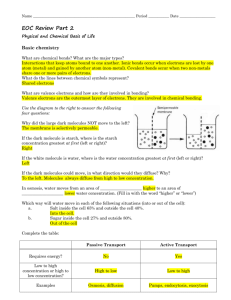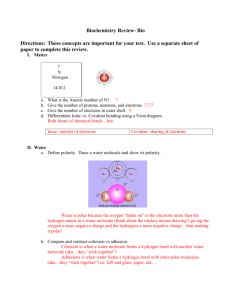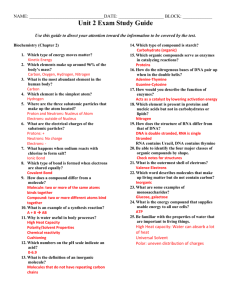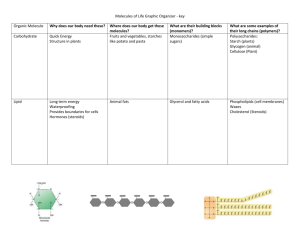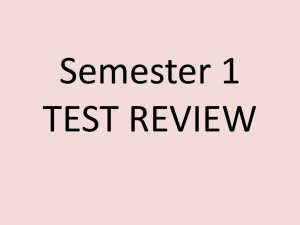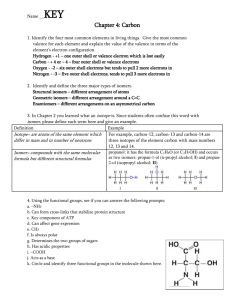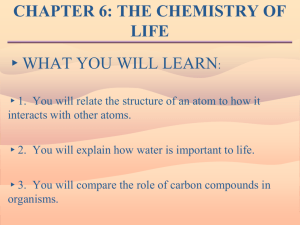Chapter 2 Worksheet: Chemistry of Life
advertisement
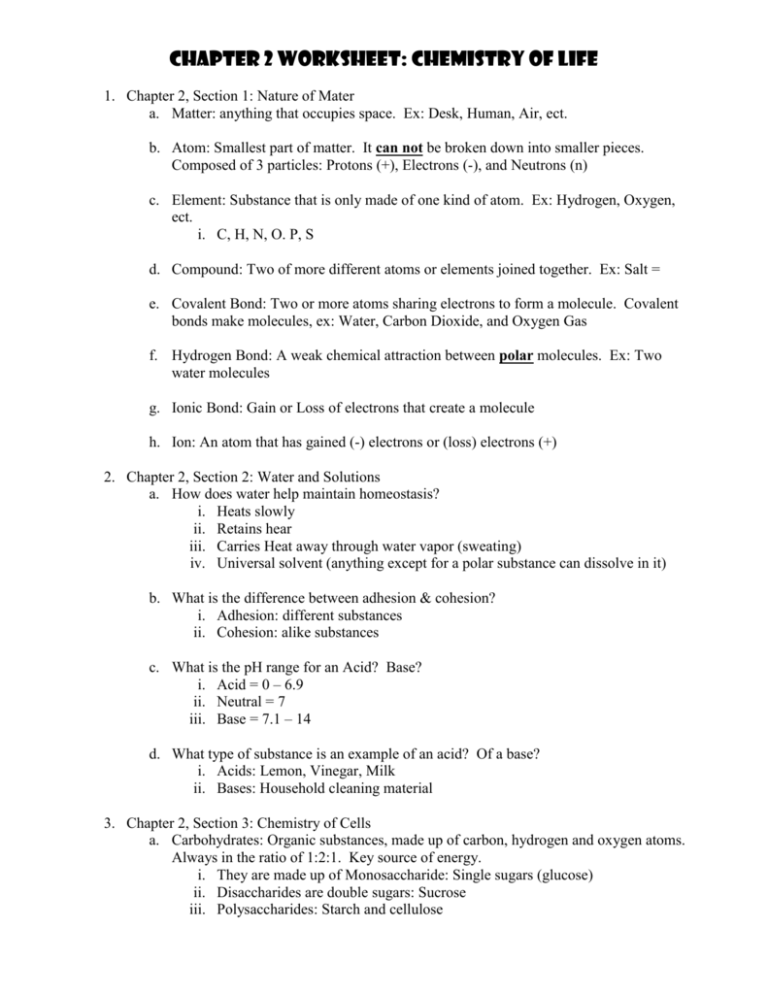
Chapter 2 Worksheet: Chemistry of Life 1. Chapter 2, Section 1: Nature of Mater a. Matter: anything that occupies space. Ex: Desk, Human, Air, ect. b. Atom: Smallest part of matter. It can not be broken down into smaller pieces. Composed of 3 particles: Protons (+), Electrons (-), and Neutrons (n) c. Element: Substance that is only made of one kind of atom. Ex: Hydrogen, Oxygen, ect. i. C, H, N, O. P, S d. Compound: Two of more different atoms or elements joined together. Ex: Salt = e. Covalent Bond: Two or more atoms sharing electrons to form a molecule. Covalent bonds make molecules, ex: Water, Carbon Dioxide, and Oxygen Gas f. Hydrogen Bond: A weak chemical attraction between polar molecules. Ex: Two water molecules g. Ionic Bond: Gain or Loss of electrons that create a molecule h. Ion: An atom that has gained (-) electrons or (loss) electrons (+) 2. Chapter 2, Section 2: Water and Solutions a. How does water help maintain homeostasis? i. Heats slowly ii. Retains hear iii. Carries Heat away through water vapor (sweating) iv. Universal solvent (anything except for a polar substance can dissolve in it) b. What is the difference between adhesion & cohesion? i. Adhesion: different substances ii. Cohesion: alike substances c. What is the pH range for an Acid? Base? i. Acid = 0 – 6.9 ii. Neutral = 7 iii. Base = 7.1 – 14 d. What type of substance is an example of an acid? Of a base? i. Acids: Lemon, Vinegar, Milk ii. Bases: Household cleaning material 3. Chapter 2, Section 3: Chemistry of Cells a. Carbohydrates: Organic substances, made up of carbon, hydrogen and oxygen atoms. Always in the ratio of 1:2:1. Key source of energy. i. They are made up of Monosaccharide: Single sugars (glucose) ii. Disaccharides are double sugars: Sucrose iii. Polysaccharides: Starch and cellulose b. Lipids: Nonpolar substances that are not soluble in water i. Include: Fats, phospholipids, steroids, and waxes ii. Make up the outside of cell membranes iii. Store energy iv. Fats can be saturated or unsaturated c. Proteins: A chain of molecules called amino acids linked together i. There are 20 different aa in proteins 1. 10 of those your body can make on your own, the other 10 you need to consume in your diet ii. Promote chemical reactions in your body = enzymes iii. Collagen iv. Hemoglobin d. Nucleic Acids: a long chain of nucleotides (sugar, base, and phosphate group) i. 2 types: 1. DNA: Double stranded, found in your chromosomes, helps make proteins 2. RNA: Single stranded, also helps make proteins Another important molecule in your body: ATP: Adenosine triphosphate: Main energy unit of cells 4. Chapter 2, Section 4: Energy and Chemical Reactions a. Energy: Ability to move or change matter. Exists in many forms: i. Light, Hear, Chemical, Mechanical, Electrical b. Activation energy: The energy needed to start a chemical reaction. (Chemical “Push”) c. Enzymes: Substances that speed up a chemical reaction i. Act as a catalysts, meaning they reduce the amount of activation energy required to start the reaction ii. Help maintain homeostasis iii. Enzymes can be affected or “denatured” by two different things: 1. extreme pH 2. extreme Temperature d. Substrate: A substance an enzyme has to bind to in order to work e. Active site: The location where the enzyme and substrate combine at.

